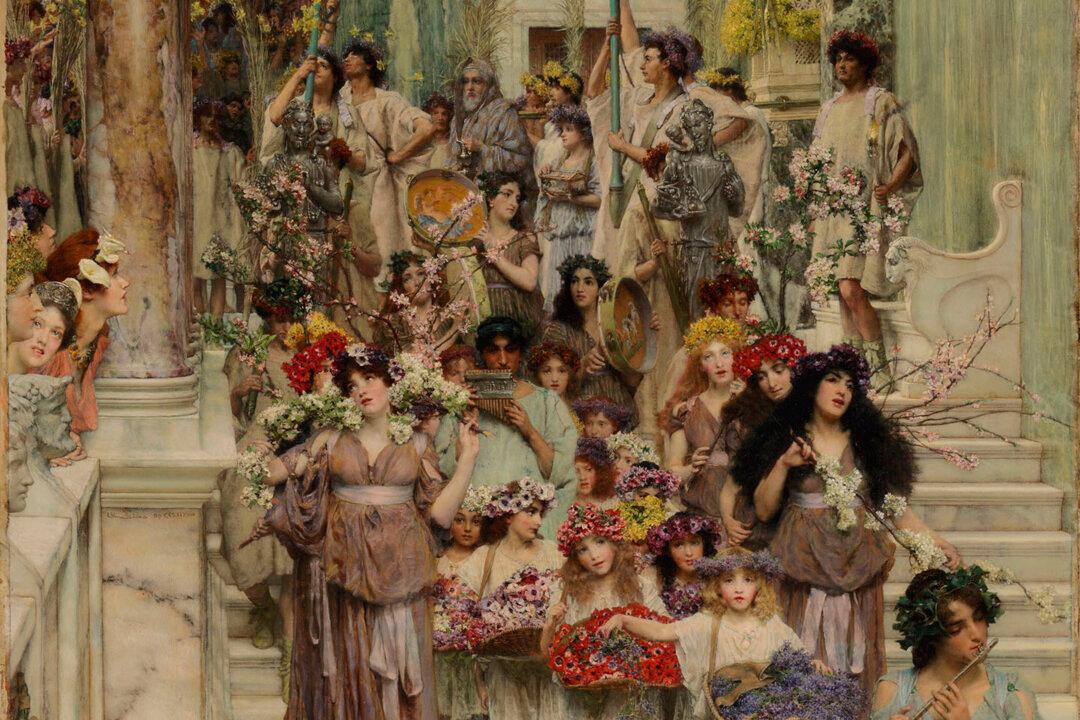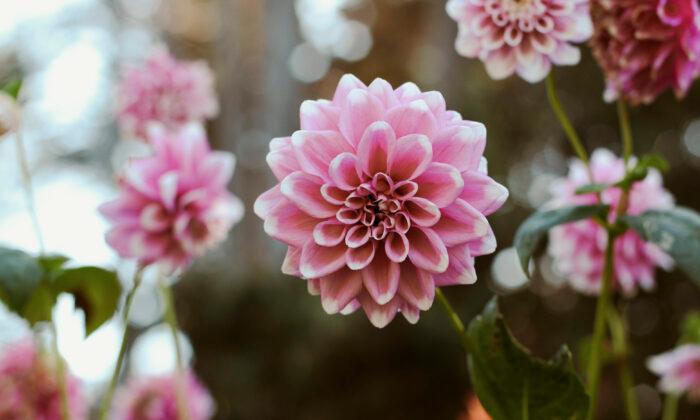Masterful works of art are often multilayered and complex. What meets the eye at first glance may conceal messages within a work’s more obscure and often overlooked details. Throughout history, groups of people from various classes and backgrounds have had access to different and at times contradictory levels of understanding when it comes to certain works of art.
With philosophical and metaphysical implications, artworks may channel charged symbols, ceremonial significance, and ancient mythology into the conscious and/or subconscious mind of the viewer. As more people are noticing the subversive elements within popular culture, we are realizing that it is important to look at all forms of art, past and present, with discerning eyes. As they say, “the devil is in the details.”
On the surface, it is easy to see why “Spring” is one of the most popular paintings at the Getty Museum, in Los Angeles. Sir Lawrence Alma Tadema’s well-known painting appears to innocently portray a procession of people engaged in a joyful celebration of the flourishing of springtime. Viewers in Victorian England would have looked at this parade’s voluminous array of beautiful flowers through the lens of their own celebratory “May Day” festivities.
At first sight, the painting is an aesthetically pleasing symphony of vibrant faces, colorful flowers, and meticulously detailed marble architecture. Alma Tadema repeatedly depicted the ornate grandeur of classical antiquity, overlaying perceptions of ancient empire with the far-reaching might and wealth of the British Empire of his time.
Sir Lawrence Alma Tadema was a rare type of person in this world: a wealthy artist. As a young man in Belgium, he received the honor of being named a knight in the “Order of Leopold.” After achieving success in his homeland, Alma Tadema’s artworks were sent to London, where he quickly gained fame. This success led him to receive a membership in the Royal Academy and, later, a knighthood from Queen Victoria. His great success as an artist enabled him to create an estate modeled on a Pompeiian villa, where he would often host lavish parties.
The Significance of “Spring”

Alma Tadema’s “Spring” was the result of four years of work leading up to 1894. The painting features dozens of figures marching into a temple in honor of Cerealia, Floralia, or an amalgam of both Roman festivals. In 1879, he painted “On the Road to the Temple of Ceres: A Spring Festival,” and it is speculated that “Spring,” painted a decade and a half later, also depicts the arrival of a similar procession at the Temple of Ceres (the Roman fertility goddess) or a temple dedicated to Flora (the Roman goddess of flowers). The adornments of the characters of “Spring,” many of whom have their arms thrown up in reverence, suggest that the extravagant setting is intended to be a place of worship.
May Day or “Maying” festivals were revived in Victorian England as celebrations of springtime and community, and the public would have readily identified with aspects of the ritual that Alma Tadema depicted despite the scene’s placement in ancient Rome. Most of the casual visitors to the Royal Gallery in London likely admired this work simply for its association with May festivals and its masterful artisanship. On the other hand, Alma Tadema’s primary audience—the upper class—would likely have had a more personal identification with the painting, keen to view themselves as the English version of the Roman empire. Due to their status, and with a more extensive knowledge of the mythology of classical antiquity, this more educated, wealthy class may have had an interest in the continuation of ancient esoteric customs.
Hidden in Plain Sight
Scientific and social viewpoints have become increasingly secularized since the Industrial Revolution. Nevertheless, groups of people throughout society, and especially those few at the upper echelons of the economic ladder, continue to view the world anything but secularly. As J.P. Morgan said, “Millionaires don’t use astrology, billionaires do”; knowledge and practices from ancient civilizations have been handed down and continue to be used in occult rituals. Bearing this in mind, we’ll examine some of the peculiar details analyzed in Louise Lippincott’s well-researched book about “Spring.”Toward the center of the procession are two silver sculptures depicting satyrs, carried behind and above a procession of young girls and women by four men, illustrating their importance to the festival. These satyr figures are based on various Roman sculptures depicting “Satyr and Infant Bacchus.” The infant Bacchus on their shoulders is a representation of the Roman god of wine and inebriation. Lippincott elaborates that “the presence of satyrs usually indicates that innocence is threatened if not already lost” and that “the theme of naked young women resisting or fleeing amorous satyrs enjoyed a venerable tradition” in the distant past. However, in 19th-century Victorian England, the subject understandably met with disapproval and therefore received more “suggestive treatment” by the artists who chose to portray it.
The male figure playing flutes is described by Lippincott as “a satyr in shepherd’s clothing. His long nose, mysterious eyes, and hair swept up above his ears like little horns betray his origins, as do his panpipes.” He appears out of place among the girls who are oblivious to his presence. The form of his long nose is echoed on a bench sculpture to his right. This sculpture is peculiar because what you would expect to be the head of a lion with (lionlike paws) is revealed to be a goat head with horns. As Lippincott explains, “Satyrs, part human and part goat, followers of the great god Pan, lived in a state of constant sexual readiness. Their sly assaults on various humans and goddesses constituted their principal claim to fame in the annals of classical mythology.”


Erotic images of nude satyrs and maenads (women who lived in the wild under the protection of Bacchus) are very subtly included on the tambourines being played by girls in the procession. What is the significance of satyrs and maenads featured repeatedly in “Spring?” Lippincott reflects that “Both creatures represent the sexual dangers lurking in the woods, presumably awaiting May celebrants innocently gathering flowers.” This point is important given that the Victorian public participated in their own May celebrations that included gathering flowers in the woods.
One of the most well-hidden examples of Alma Tadema’s mischievousness is his allusion to a sculpture from the Temple of Apollo, “The Battle of the Lapiths and the Centaurs.” In the sculpture, which Alma Tadema painted as a relief ornamenting the far-left building, women are being abused by drunken centaurs. In her discovery of this easily overlooked element, Lippincott concludes that beyond just hinting at these improprieties, “Alma Tadema snuck an actual rape scene into the picture.” She goes on to say, “Neither satyrs participating in a celebration of floral beauty and female purity nor Bacchic decorations seem especially appropriate to the occasion” and they “certainly subvert the Victorian primness of Alma Tadema’s May festival.”

The Latin inscription on the gold standard near the center of the composition provides another clue. It translates to “I dedicate, I consecrate this grove to thee, Priapus, whose home and woodlands are at Lampsacus.” The verses come from a poem by Catullus, an author of erotic poetry who had a “scandalous reputation” in the Victorian era. Priapus, Roman god of nature, gardens, and fertility, was commonly portrayed throughout ancient Rome in ithyphallic sculptures (meaning with aroused genitalia). Lippincott suggests that the dedication of “Spring” to Priapus “transforms the painting from a solemn scene into a racy joke. Even the character of Flora, the goddess of the day, changes in association with Priapus. Goddess of flowers, she was also the notorious patroness of prostitutes, who were among the principal celebrants of the Floralia. Thus, even the apparent innocence of ‘Spring’’s parading beauties is called into question.”

Historical juxtaposition
Alma Tadema’s “Spring” festival existed in stark contrast to other artistic representations of spring of the time. Lippincott analyzes the historical positioning of the painting by explaining that “There were two May Days in England in the 1890’s: the elite historicizing festivals exemplified by ‘Spring,’ and the workers’ Hyde Park rallies.” An international labor movement declared the first of May to be “International Labor Day” in 1889, and working men peaceably sought reforms that would limit industrial working hours. In May of the following years, massive strikes were orchestrated throughout Europe. In 1891, horror awaited the movement when many deaths resulted from troops firing on peaceful demonstrators, especially in Italy and France. This governmental violence was evidence that the mass demonstrations were a threat to the status quo. Alma Tadema’s painting, lauded by royal society, may have been part of an effort to reclaim the first of May by idealizing the picture of empire while secretly paying tribute to mythical, metaphysical forces.
Other artists of the time were creating very contrary pictures of May Day celebrations and demonstrations. Walter Crane used the Maying theme in support of the workers’ cause by producing banners and prints that illustrated their beliefs. His most famous print, “The Triumph of Labour,” has themes similar to those of “Spring,” such as processions, garlands, standard-bearers, and tambourine players. Crane’s work openly features the goddess Liberty, and his procession is composed of people holding signs with messages including “Labour is the source of wealth” and “Equality, Liberty, Fraternity.” As Lippincott explains, “Since the workers steadfastly opposed imperialism, believing that cheap imported goods eroded the value of labor, Crane replaced references to ancient Rome with allusions to the traditional English countryside.”
Alma Tadema’s work fell out of favor as the British Empire weakened in the 20th century. Though aesthetically beautiful at first glance, “Spring” is insidious in its details and historical intent. The painting was a reaction to the labor movement, and Alma Tadema’s defense of an elitist, royal lifestyle. It is not his only painting to dabble in esotericism; “The Roses of Heliogabalus” includes similarly dark themes from classical antiquity and less subtle hints at power’s perverse potential for all kinds of abuses including debauchery and murder.

Art in all forms is food for our consciousness, and what we choose to consume has an effect on us. As darker aspects of culture are brought into light, we must look at art through the lens of awareness. When we watch movies, listen to music, or look at works of fine art, it is important to realize that deceptive forces can conspire to imbue them with occult details that may not be in the public’s best interest. In “Spring,” Sir Lawrence Alma Tadema reminds us that this is nothing new.








